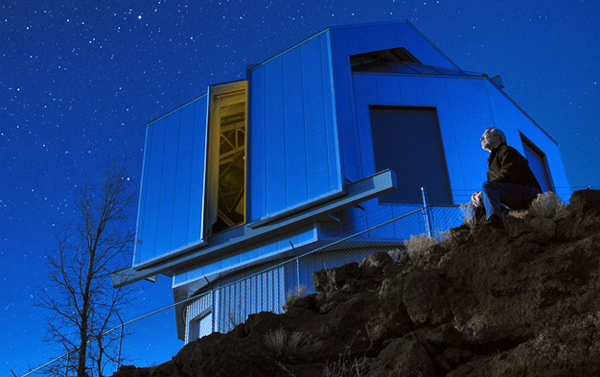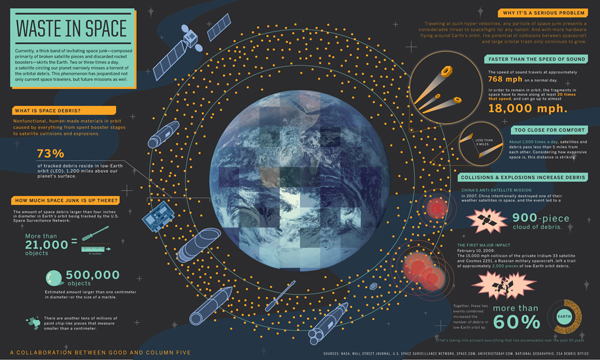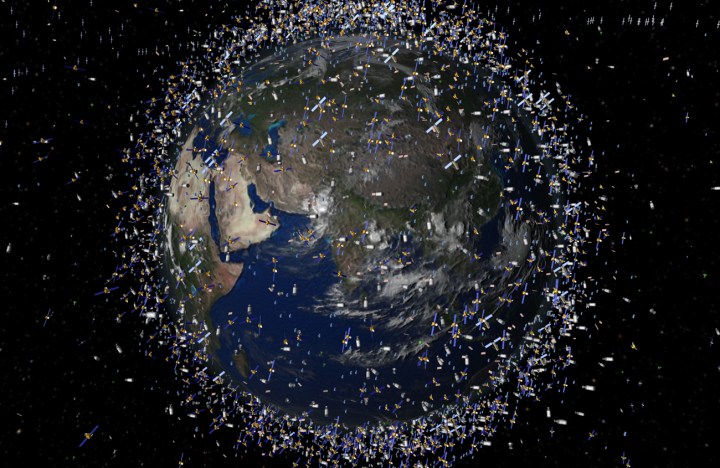Virgin Galactic has come to town to open space travel sales to Mark Shuttleworth wannabes who boldly want to go where few men or women have gone before. From a famous split infinitive to a glimpse of infinity perhaps. But you might want to ensure they've sent a space minesweeper ahead to get rid of the space junk first. By MANDY DE WAAL.
“Twenty years from now you will be more disappointed by the things that you didn’t do than by the ones you did do. So throw off the bowlines. Sail away from the safe harbour. Catch the trade winds in your sails. Explore. Dream. Discover.”
The pony-tailed creative types who put together Virgin Galactic’s corporate brochure must have had a bit more than the usual snap and crackle in their Rice Krispies on the day they elected to use Mark Twain’s archetypal quote to sell space travel.
Humans with money have pretty much done everything. If you’re Donald Trump Jr you’ve killed that leopard or if you’re Richard Branson you’ve bought Necker Island. How do you get your jollies once you’ve bought that NBA team, sailed the America’s Cup or circumnavigated the globe in a hot air balloon?
Outer space.
Branson’s already bought his ticket – of course he would, given that Virgin has entered the space tourism race. Private space travel had its genesis in SpaceShipOne, a suborbital air-launched spaceplane that was funded by Microsoft co-founder Paul Allen and American aerospace engineer Burt Rutan.
Californian Allen had been building aircraft, or at least models of them, since he was eight years old. And in 2004 Rutan realised a long-held dream by becoming the first man to privately enter space – twice in the same week. Very soon afterward Virgin Galactic started working on the world’s first commercial spaceline.
Based on Rutan’s prototype SpaceShipOne, Virgin Galactic’s craft is called SpaceShipTwo and the sales spiel for the tickets – at a mere $200,000 (R1.5m) a pop – sounds like sheer poetry. The local elite loves the Twainish promotional literature, because two South Africans have already purchased their tickets. The experience they’re getting for that is supposed to go a little something like this. Once you’ve been readied for space travel, which only takes a couple of days, you meet with your crew and it is go time.
“The climb to 50,000ft (15,200m) is marked with quiet contemplation but there’s an air of confidence and eager anticipation,” the promotional material reads. “Then the countdown to release, a brief moment of quiet before a wave of unimaginable but controlled power surges through the craft. You are instantly pinned back into your seat, overwhelmed but enthralled by the howl of the rocket motor and the eye-watering acceleration which, as you watch the read-out, has you travelling in a matter of seconds, at almost 3,000mph (4,828kmh), nearly 4 times the speed of sound.”
“Outside SpaceShipTwo’s windows the soft blue atmosphere melts into the black infinity of space,” Virgin Galactic’s brochure continues. “As you hurtle through the atmosphere’s edges, the large windows show the sky turning from cobalt blue to black. You’re on a high, you’re loving it.”
Um. Hold the bus.
Has anybody heard about Don Kessler, the creator of the said-to-be-famous “Kessler Syndrome” theory?

Photo: The Father of Space Junk, Donald Kessler. (Photo courtesy of Space Junk 3D, LLC.)
In the late 70s, Kessler, a now retired Nasa scientist, penned a seminal paper called: “Collision Frequency of Artificial Satellites: The Creation of a Debris Belt”. In it he wrote: “As the number of artificial satellites in earth orbit increases, the probability of collisions between satellites also increases. Satellite collisions would produce orbiting fragments, each of which would increase the probability of further collisions, leading to the growth of a belt of debris around the earth. This process parallels certain theories concerning the growth of the asteroid belt. The debris flux in such an earth-orbiting belt could exceed the natural meteoroid flux, affecting future spacecraft designs.”
Kessler used a mathematical model to project the rate at which the asteroid belt he described in his paper would form, and came to the conclusion that, given the right conditions, the debris-filled belt could form as early as this century.
If you travel to Asheville, North Carolina, where Kessler lives and it’s a clear, winter’s night, there’s a good chance that you’ll find the retired scientist peering into his 1978 Celestron telescope. What’s more, he’ll probably tell you that when he came up with that theory his bosses at Nasa weren’t too enthusiastic about his research.
But after the paper was published, enough of the right people started paying attention and the Nasa Orbital Debris Program Office at the Johnson Space Centre was established. Today the office keeps watch over 21,000 orbital pieces of debris over the size of 10cm, but says that 500,000 particles between 1cm and 10cm in diameter exist, The number of particles smaller than 1cm exceeds 100 million.
Kessler’s theory of cascading space junk collisions was vindicated after he retired. At the start of 2009, two satellites collided into each other 789km above the Siberian tundra. Wired magazine reports that the satellites were travelling at about 8km per second when Iridium 33, which was relaying phone conversations, crashed into an old Russian communications orbiter called Kosmos 2251. On impact both objects smashed into smithereens – 2,100 pieces to be exact.
“The wreckage quickly expanded into a cloud of debris, each shard an orbiting cannonball capable of destroying yet another hunk of high-priced hardware,” writes author Evan I Schwartz for Wired. The encounter played out exactly as Kessler had predicted 30 years earlier. The satellite crash was the smoking gun that converted Kessler’s theory from prediction into fact.
“Some people weren’t aware how fast these objects are going. At those speeds, even something quite small can create tremendous damage,” Kessler told Schwartz. The fall-out from Iridium 33 was minimal. Iridium Satellite LLC took one of its in-orbit spare satellites to replace the one it had lost, and the Orbital Debris Program had a little more junk to keep an eye on.

Photo: Waste in space infographic.
But scarcely a month later something really unnerving happened. The International Space Station, that intergalactic laboratory for conducting scientific research that can only be done in outer space, had a chunk of space debris hurtling towards it. The crew evacuated the $100-billion satellite that usually flies in a low earth orbit, and bunkered in a Russian-made Soyuz capsule waiting for impact.
It never came. The piece of space junk – a stray motor – passed by the space station with only a few kilometres to spare. Now, in earth terms you’d hardly call something that passed by you with kilometres to spare a miss, but in space a couple of kilometres is what one calls a close shave. Then there’s the fact that a Nasa satellite fell to earth last year, and a Russian probe dropped out of the sky this year.
But the problem isn’t so much space debris falling to earth because about 70% of the planet is water and smaller pieces of space junk invariably burn up on entry into earth’s atmosphere. The bigger pieces that do land from time to time are a bit of an issue. The real nightmare that’s keeping Nasa awake at night, however, is the growing amount of space debris, and the potential for it colliding with the space station or an intergalactic private craft taking tourists into outer space.
A recent report by the US non-profit science policy outfit, the National Research Council, indicates that there’s now so much space debris that it has sounded an alarm about a tipping point where space collisions could increase incrementally. The council called on Nasa to develop a formal strategy for tracking space junk, and to look at removing debris.
So before paying $200,000 for a space trip courtesy of Virgin Galactic, perhaps the uber wealthy should invest in a space clean-up operation. Or at the very least buy a movie ticket and go see Space Junk in 3D instead. This new documentary trounces the romantic view of space dreams by instead looking at the very real and troubling legacy of 50 years of space exploration. That is, the growing ring of rubbish that threatens future space exploration and which could very well bring the less useful intergalactic tourism sector crashing back to earth. DM
Read more:
- For Space Mess, Scientists Seek Celestial Broom in The New York Times.
- Space: The Final Frontier for Our Junk in Slate.
- Space Debris Has Reached A ‘Tipping Point’ at NPR.
- Google pair back plan to lasso asteroids and mine them for precious metals in the Guardian.
- Swiss create ‘janitor satellite’ to clean up space in the Guardian.
- Watch the trailer for Space Junk.
Photo: Space Junk. (Illustration courtesy European Space Agency)






 Become an Insider
Become an Insider